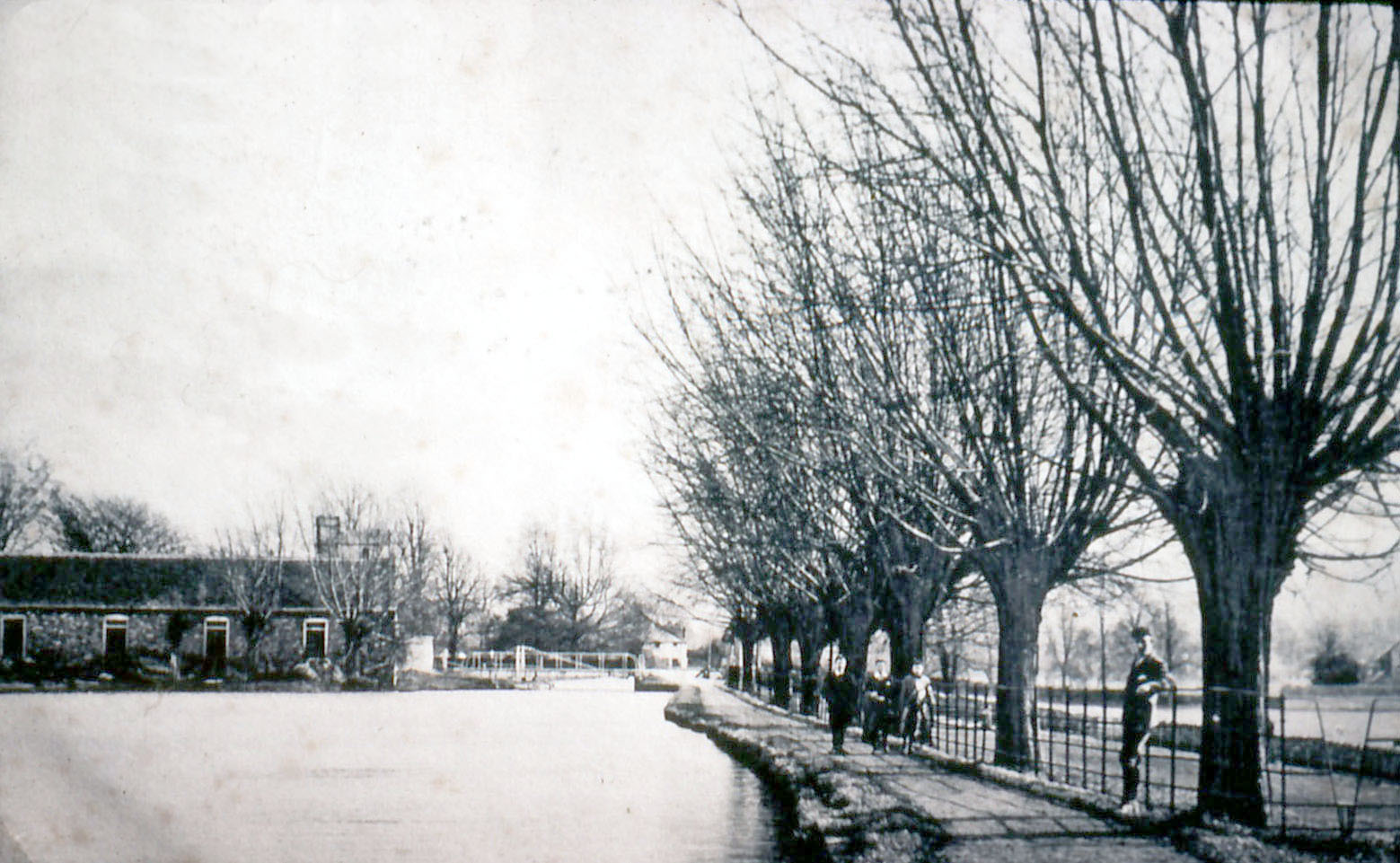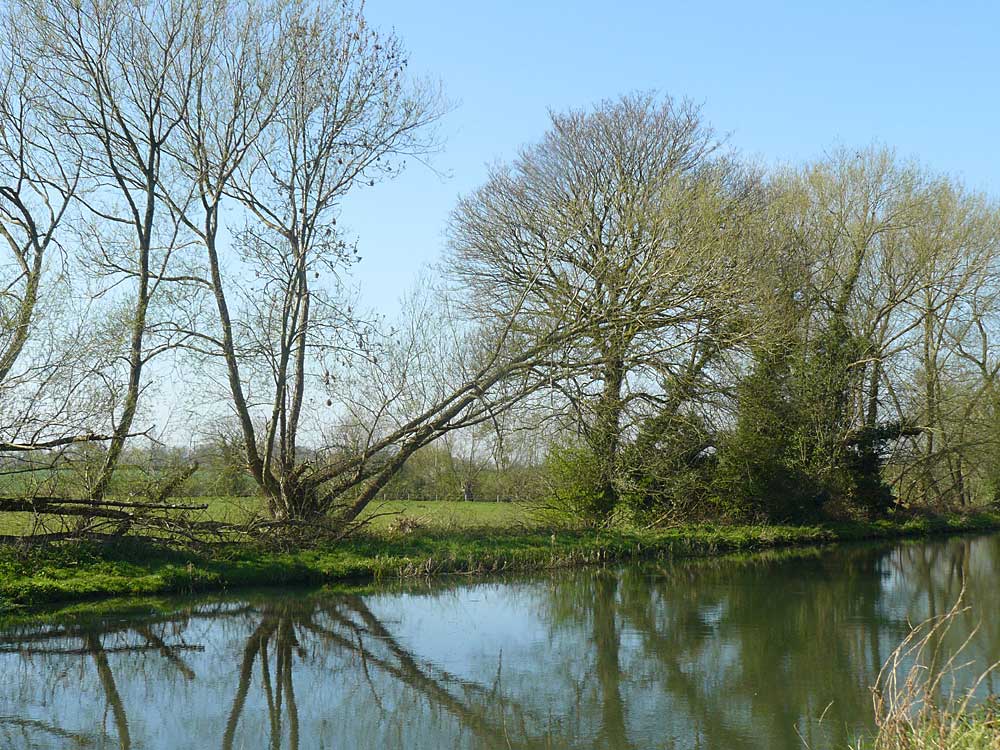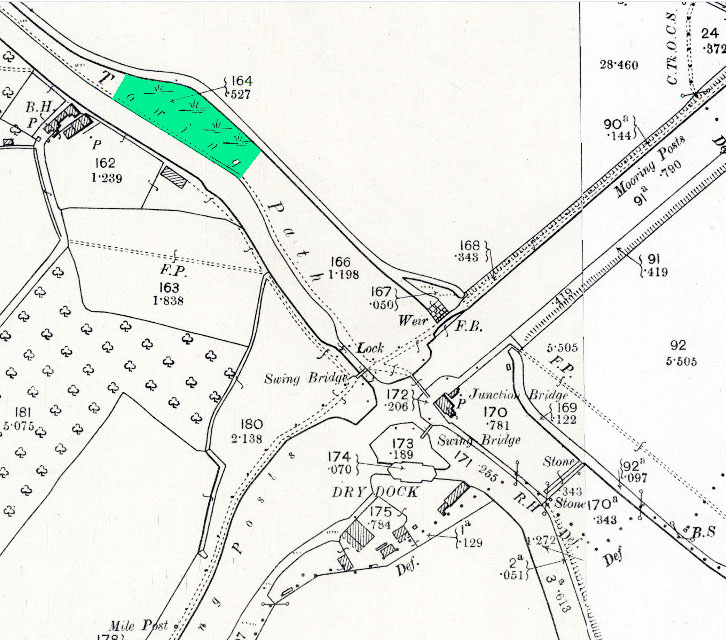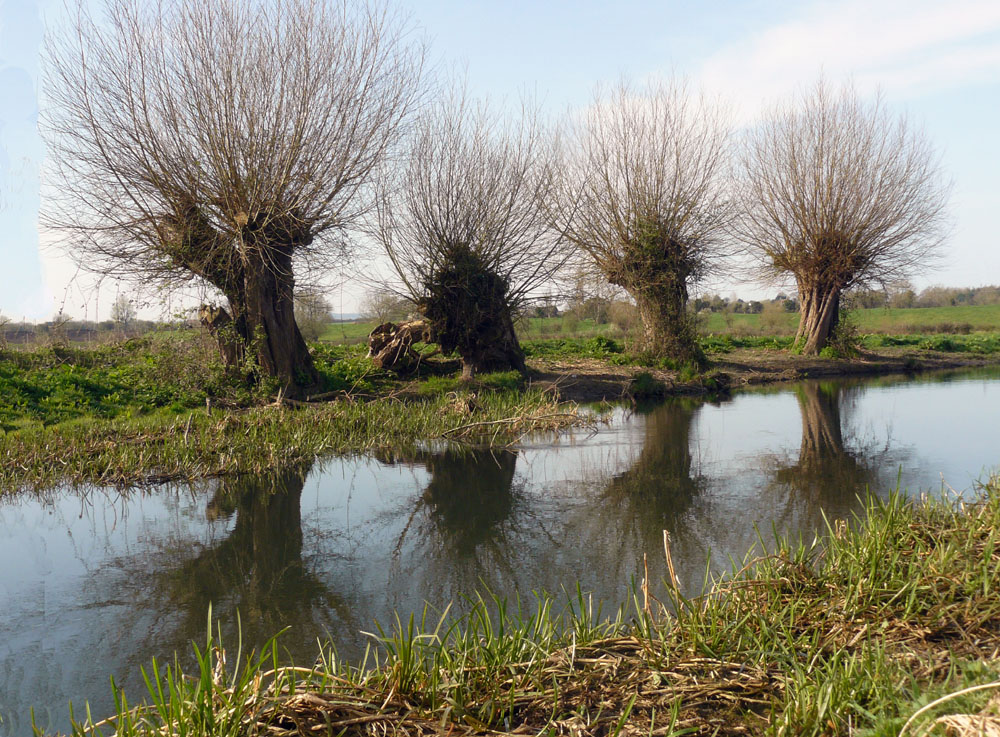Diana Crane highlights the importance of withies that were common along the lower Frome valley and were sold for making baskets and hurdles.


The chief income of any commercial canal company came from tolls on traffic and wharfage charges, but there were other sources. The Stroudwater Navigation Company was always keen to profit from all its assets, and one such source was the cultivation of willows for commercial use. Baskets had multiple uses at the time and there was a ready market for withies, which were willow shoots suitable for basketry. The Stroudwater Company itself was a user of baskets, at least in its early days. The Committee in 1777 ordered that baskets should be purchased for the measurement of slack coal. This was coal consisting of fine nuggets to dust and was in demand for banking fires so they would not go out overnight. The use of baskets continued until 1821 when it was decided that in future statute bushels with iron rims would be used instead.
Willows require damp land and sunlight, and land purchased for the canal in the lower Frome valley had areas providing both. Some of the land may have been producing withies already. Cultivation is relatively simple: unrooted cuttings, or setts, of a suitable willow species are planted directly in the ground in winter and will root readily and grow on rapidly: they can be harvested as soon as they have reached a suitable length and thickness. They will shoot again in the following year and once well-established can be managed by coppicing or pollarding. Depending on the interval between cuttings, basketry withies, fencing material or poles may be produced. Willow trees used in this way were often referred to as osiers. Managing bankside willows in this way, as well as producing a saleable crop, had the additional benefit of preventing leaves or even branches spreading over or at worst falling into the canal.
The Stroudwater Company's records include many accounts of cultivating withies on company property and some of withies on neighbouring land. There are also a few references to willows which do not make it clear whether the trees were being actively cropped or left to grow naturally. The first reference in 1779 records an agreement that withy trees next to a Mr Knight’s garden could be sold to him so they could be taken down. The deliberate planting of withies is first mentioned in 1780, when the Committee ordered that ‘the towpath be mounded with withy setts and hurdles from Mr Ewin’s house to Mr Reddall’s little orchard.’ The intention here was probably to delineate the towpath. This was followed in 1781 by an order to Mr Benjamin Grazebrook to ‘agree with some Person for planting Wythy setts in such bitts of the Line belonging to the Company as are suitable for the purpose’. Mr William Hutchins acquired the setts, prepared the ground and planted the setts at the price of 2s 6d per hundred. In 1786, when the initial plantings should have matured sufficiently to provide a decent yield, a Mr Hawker applied to buy the crop: this was agreed for 8 guineas per year for a term not exceeding 8 years, the Crops to be brought up the Canal at the expense of the Company without any further charge of tonnage or freight; or they might be sold annually to Mr Hawker at market price. This name Hawker could be a mis-writing of Hawkins which appears later in the records.
At this time it is likely that the Company's workmen were able to undertake care and harvesting of the bankside trees and withy beds as part of their regular duties. As time passed, it appears that the withy beds continued to be cared for and let out or occasionally sold where the Committee saw an opportunity for profit. In 1788 ‘all the withy beds at Whitminster’ were leased to Seth Cox for 2 years at 5 guineas per annum. In 1795 a piece of pasture land with a withy bed on the west side of canal at Lockham Bridge was sold to a Mr Burgh for £32. In 1801, Mr Harris of Stonehouse applied to purchase willow trees on the land adjoining his: ‘the whole of the Willow Trees growing both on the Ground nearest to that of Mr Harris, and on that in the next field adjoining consisting of 139 or 140 Trees [were] offered to Mr Harris for the Sum of £100 to be paid previous to his cutting down any part of them on or before the 1st of June next.’ In 1814 it was noted that withy trees on the banks of the canal at Stonehouse were to be sold to the best buyer. A little later that year, Farmer Daniels was asked to top the willows hanging over the canal at Ebley.


In the next fifty years, just enough is heard of the withy beds in the Committee minutes to show that they continued to be cared for: in the face of the general prosperity of the Canal Company their financial yield was of little importance. In 1836, the Committee instructed that all the poles in the Lockham Bridge withy bed should be removed into store. In 1840, mud and rushes were ordered to be dug out of the canal at a culvert below Lockham Bridge opposite Mrs Hawkins’ withy bed. In 1848, some withy plants were to be set on the south side of the towing path between Ryeford Mill and Double Lock.
From the 1840s onwards railway competition was increasingly felt and brought a steep decline in the canal’s financial fortunes. The withy enterprise evidently began to seem a more significant contributor to the canal’s income and references to the withy beds in the records increase markedly. In 1872 Henry Fallows, the foreman at Eastington Yard was required to ‘prepare slabbing and fence the Ocean [at Stonehouse] in line with the willow trees as this appears to have been the boundary’. This had been controversial but in 1880 the Committee minutes note that Mr Marling had accepted that the withy trees at the top of the Ocean marked the extent of the Company’s property there. After Mr Marling senior died, it was deemed necessary to confirm the boundary with his son, and in 1884 a plan was produced which delineated the positions of withy trees ‘belonging to Stonehouse Court Estate and others belonging to this Company.’ In 1886 Mr Henry Lewis was required to pay £1 2s 6d for the value of his inadvertently lopping the Company’s withy trees at the top of the Ocean at Stonehouse.
In December 1886 the clerk was instructed to get the price of planting land near the Junction with withy setts and he consulted with Jackson & Co, well-known basket-makers at Westbury on Severn for advice on the planting of 0.75 acres. Orders were given to proceed early in 1887. In February, the land was treated with ashes and 2000 osier setts were ordered from Mr Jackson. Planting went ahead at a cost of £2 12s 10d, after £3 14s obtained from sale of some poplar trees from the site had been taken into account. Later this month a second order of osier setts was made for Stonehouse Ocean: Jackson & Co were requested to supply ‘good setts, last lot mixed’. The account was settled in March with a postal order for £1.0.0. for 2000 setts and a little later the setts were planted.
Just after this the Company was troubled again by illegal lopping of its trees, this time by Messrs Webb & Spring near Ryeford. The clerk was ordered to see to the removal and sale of the loppings: they were sold to Miss Lewis for 14s. In June the withy beds at Stonehouse and the Junction were inspected by the Committee; in July Charles Saunders, the wharfinger at Framilode, was ordered to attend to the weeds and docks in the Withyland at the Junction. In September, the clerk noticed damage to withy trees between Double Locks and Ryeford and wrote to Sergeant Browning of the Police, requesting him to ask his men to look out for offenders when patrolling in the area. In December, we learn that Mr Fallows, the foreman at Eastington had met with Jackson & Co over the state of the withy bed at the Junction. After an inspection by their representative, it was agreed that Jackson & Co would cut back and remove the dead withy shoots and replace them with fresh setts in due season. In July of the next year, the clerk writes to Mr Fallows again, asking him to enquire into the health of Mr Saunders at Framilode, following a report he has received – could he please render any assistance he requires, as ‘the withy bed must be attended to and not neglected’.
In October 1889, the Chairman reported on a meeting with Mr Knowles of Stonehouse, concerning a piece of land and ‘18 willows growing thereon’ belonging to the Trustees of the Stonehouse Court Estate. This was to be purchased by the Canal Company for £107 for use as a mud tip, with stipulations regarding fencing and road access to the remaining portion of the land. The Company Solicitor was instructed to take this forward without delay. In January 1890 an order was given to plant the withy bed near the Junction with osiers. Two months later, Mr Snape, Clerk of the Stroudwater Company reported to the Committee that this had been done.
In March 1890, a Committee meeting was held where Mr Snape reported that he had observed osier setts planted beside the canal at Stonehouse by Mr Sibly of Wycliffe College. They were in the water, a ‘manifest trespass’. The Committee instructed Mr Snape to send a letter to Mr Sibly, to be approved by the Company Solicitor before it was sent. This letter and Mr Sibly’s response were shown to the Committee at its next meeting – the contents were not recorded. Mr Snape was instructed to meet Mr Sibly to discuss the matter. In April he wrote to Mr Sibly, pointing out that the osiers were on Company land and if left to grow on there would be the property of the Company. He suggested that they might be moved onto land owned by Mr Sibly the following winter. This suggestion was evidently not well received as it was followed by a meeting, at which it appears Mr Sibly was the victor: at the next Committee meeting Mr Snape reported that he had satisfied himself on the spot that the osiers planted by Mr Sibly ‘are not so placed as to trespass on the canal’.


In December 1893 the clerk offered osier cuttings at the Junction to Mr Jackson for 1s 6d per bundle, cut by him and made into bundles measuring 40 inches round the butt end and the same six inches above. Mr Snape asks to be informed when they wish to cut so that a man could be sent, as none should be cut unless the Company representative was present. If Jackson chose to go out of the lock into the river he would be allowed to pass free. This is followed in January 1894 by an offer of osiers from the Ocean at 1s 6d, cut by the Company and the osiers at the mud bank, if two years old, at a little less. The osiers would be delivered to Eastington on a chosen day and Jackson would be allowed free passage from Framilode to Eastington for collection. In December 1895, in response to a request from Jackson, he was offered the osiers at the Junction and, if he agreed to give 1s per bundle, those at Stonehouse, cut and delivered at Framilode Lock. Either the quality of the crop was declining or perhaps the value of withies in general was falling and this offer was not accepted – there was a severe economic recession in the 1890s. A week later, the price for the Junction crop dropped to 10p per bundle if cut by themselves. It seems relations were not always harmonious as the letter continues with a rather peppery tone. Mr Snape offers those cut at Stonehouse by the Company and sent down to Framilode for 1s per bundle. ‘We will make them up 3ft 3in at butt end & they shall be sent down that size and I will not allow anything if they are not that size when you get them. We had a dispute of this kind some time back & I don’t want another.’ There is no mention of a sale of withies in 1896 and in 1897, an offer of 1s 2d per bundle, cut by the Company and delivered at Dudbridge was accepted from a Mr Sandling. In Dec 1898, the clerk reported that the National Telephone Company had cut the withy trees at Ryeford without authority causing injury to the trees which he estimated at £2. Fortunately, the Telephone Company promised to pay the £2 compensation.
In April 1902, the clerk reported that he had been unable to sell the osiers at Eastington He was instructed to offer the 70 bundles to Mr J.S. King, a basket maker of Nailsworth. At the next Committee meeting the clerk had to report that there was no market for the crop and the suggestion was made that they should be planted at the Stonehouse mud tip or elsewhere. In November 1902, Mr Jackson’s offer to cut 3ft 3in bundles at the Ocean himself for 6d per bundle was accepted. The Company’s man Pockett would attend, observe the cut and convey the bundles to Framilode free of charge.
In 1905 the tension over the willows planted by Mr Sibly flared briefly again. Mr Snape responded sharply to a card he had received from Mr Sibly. He explains that the reason he wants the trees cut is that he does not want their leaves in the canal [this is underlined for emphasis]. ‘My men are now trimming up and if your willows are not cut by the time they get to Stonehouse they will cut them and take all away which overhang the canal.’ One can only imagine that Mr Snape’s original defeat at the time of the planting continued to rankle.
In 1909 a letter concerning withies to a Mr Hooper is evidently discussing a price offer. Mr Snape stated that the price mentioned (25 shillings) seemed very low and he would need to make a site inspection. Nothing more is heard of this. Later in 1909 the willows at the Ocean are discussed again. In this case the boot was on the other foot and Mr Snape had to report to Mr Winterbotham that the lock keeper had mistakenly lopped two of his trees at the Ocean, thinking they were the property of the Company. The loppings had been left in case they might be of use to him. If not Mr Snape would pay 2s per tree and send a boat for the loppings. A week later Mr Snape replied to Mr G. Brint, a dealer in osiers from Quedgeley, offering to purchase withies. Mr Snape offered bundles at 6d per bundle from the Junction, provided they were cut by him and not removed before payment was made to the Lock keeper at Eastington who would be sent to meet him at the appointed time. A little later that year, the clerk had further correspondence with the National Telephone Company. Evidently an annual charge of 10s had been established to allow the telephone company to trim certain withy trees belonging to the Company when needed. It seems this had been queried, because Mr Snape writes back that the charge was very reasonable and moderate as the cutting stopped the growth of the trees and therefore decreased their value. In November he wrote a second letter to Mr Brunsdon of Ryeford asking him to cut back withy branches overhanging the canal between the Double Lock and Mr Kimmins garden at Ryeford as they were causing annoyance to bargemen.


In 1918, piling was required at Brookside, Ryeford, where the bank was seriously undermined. This was carried out using withy stakes with bundles of withies laid beside them – a rare example of the Company recording use of its own product, though in practice this may frequently have been the case. In January 1920, Mr Jackson made an offer to purchase the withies at Framilode for 1s per bundle measuring 39 inches only around the butt and arrangements were made for Tidesman Pockett of Framilode to attend the cut. In 1923 Mr Chandler of Stonehouse Court Farm was reproved again, exactly 30 years since his last misdemeanour – this time for leaving a large amount of small brush in the waterway after lopping the withy trees near the canal: he was instructed to remove this at once. In November, a dangerous walnut tree at Eastington was offered for sale together with withy lop standing in the adjacent field. An offer of £10 for both was accepted from the Chalford Wood Workers Co Ltd, subject to cash payment. Mr Brunsdon at Ryeford was reminded that the overhanging willows between Double Locks and Ryeford were annoying the bargemen and needed to be cut back again.
In June 1926 it was noted that the withy crop was ripe for cutting and a buyer was sought: Finch & Sons of Gloucester and King of Nailsworth were both approached and an inspection by Finch was arranged but it appears no sale was forthcoming. In September, Mr Bassett the lock keeper at Dudbridge was ordered to cut back overhanging willows above the Saw Mills immediately. In January 1927, a Mr Apperly offered to cut the Framilode withies for £1 immediately and £1 to Mr Fredericks when he started cutting. Mr Pockett was to attend to the arrangements. In December, Mr Apperly offered to rent the withy bed for 10s p.a. The Committee agreed to this provided he kept the withy bed in good condition, pulled up old setts and replaced them with new as required and kept the withy bed free of weeds. The Company Solicitor was to draw up a tenancy agreement and it was pointed out that it was normal for the tenant to pay for this. These conditions may not have appealed to Mr Apperly as in April Mr Snape accepted his offer of £2 for the cuttings: £1 in advance and £1 when cutting.
In November 1928 Mr W.H. Gardener offered £2 for the Framilode crop and this was accepted. In March 1930 a Mr Butt was offered the tenancy of the field, but declined. Clearly it was becoming increasingly difficult to find a market for withies and the persistence of the Committee in trying to find a tenant suggests that maintaining the withy beds in a reasonable condition was becoming an increasing drain on resources both financial and of manpower. It must therefore have been a considerable relief when Tidesman Pockett reported in May1930 that Mr Cale, a basket maker of Quedgeley, was prepared to buy the next season’s crop for £1 and in April 1931 his offer to rent the field for £1 a year was accepted. One high spot in this dispiriting period was the offer by Messrs L.P. Foreman & Sons of Chelmsford to buy a single willow on the mud dump at Stonehouse. Mr Snape offered to meet them for an inspection and then put the offer to the Committee. The Committee were happy to accept their offer of £6. This venerable firm still exists and has matured into a successful packaging company, but in its early years it manufactured cricket bats. Perhaps this was the destiny of what must have been an exceptional tree to attract interest from so far away: perhaps a veteran tree already on the land when it was purchased in 1889. In 1932, Mr Apperly made an enquiry about loppings from the Eastington paddock and was advised to apply to Mr Beard, the tenant.
No more is recorded about withies until 1943, when there must have been complete failure to find a local market for the withy crop. The Committee suggested placing an advertisement in the Gloucester Citizen – but at the next meeting must have decided this would not be worth the cost and it was decided not to advertise after all. Now, in the post-plastic age, maybe the use of baskets will increase and a new interest in craft basketry will arise. The Stroudwater may yet see a new planting of osiers along its banks, performing their tasks of production of withies and poles, while dropping no unwanted leaves or branches into the canal and providing historical interest, along with an opportunity for local craft work.